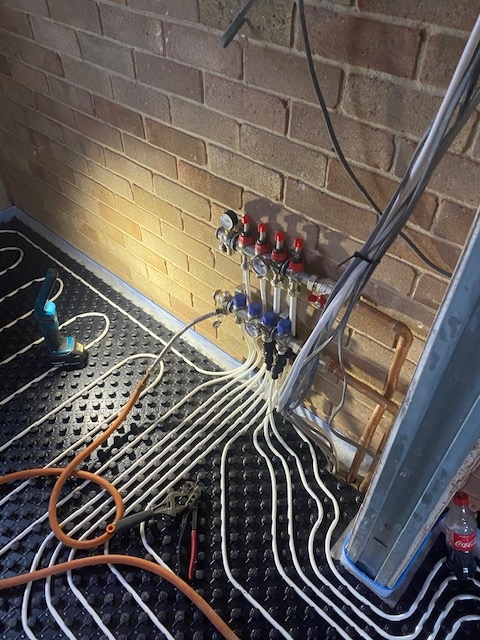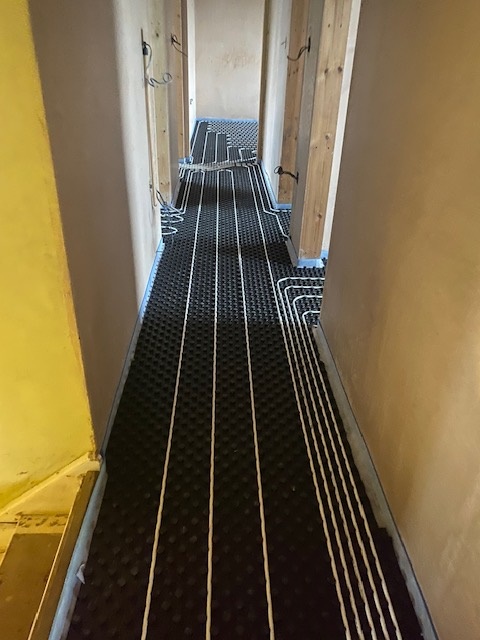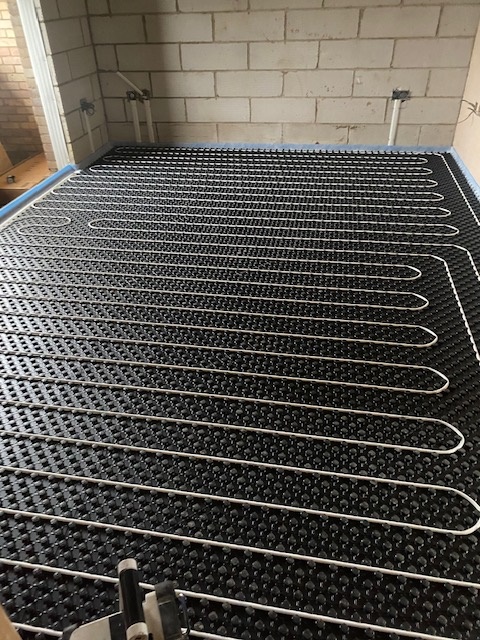Under floor heating in Portsmouth is becoming a popular way to keep homes warm and keeping commercial spaces warm and cosy during the colder months. Instead of relying on traditional radiators, under floor heating warms the floor itself, making the entire room feel comfortably warm. This method not only provides an even distribution of heat but also frees up wall space, giving your home a cleaner look. Choosing the right type of under floor heating for your home can be tricky, especially with so many options available. In this guide, we will explore the best types of under floor heating suitable for Portsmouth homes. We will look at how they work, their benefits, and which type might be the best fit for your needs. Additionally, we will answer some common questions about maintaining and installing under floor heating systems.
With this article, we aim to make you have a clear understanding of the different types of under floor heating and how to choose the best one for your Portsmouth home. Whether you are looking to upgrade your current heating system or install a new one, this guide will provide you with the information you need to make an informed decision.
What Is Under Floor Heating?
Under floor heating is a system that warms your home by heating the floor itself. It can be installed in any room but is especially popular in bathrooms, kitchens, and living areas. There are two main types of under floor heating systems: electric and water-based.
Electric Under Floor Heating
Electric under floor heating uses electric wires or mats placed under the floor. When the system is turned on, electricity flows through the wires or mats, producing heat. This heat then spreads through the floor, warming the entire room. There are two main types of electric under floor heating:
- Loose Wires: These are electric cables that are laid out under the floor. They are flexible and can be arranged to fit any room shape, making them ideal for smaller or oddly-shaped areas like bathrooms.
- Heating Mats: These are mats with electric wires woven into them. They are easier to install and are perfect for larger, more regular-shaped areas like kitchens or living rooms. The mats can be rolled out and connected to the power supply quickly.
Water-Based Under Floor Heating
Water-based under floor heating uses pipes installed under the floor to circulate hot water. The water is heated by your boiler and flows through the pipes, which then heat the floor. This type of system is also known as a hydronic system. Here’s how it works:
- Pipes: Pipes are laid out under the floor in a pattern that ensures even heat distribution. These pipes are connected to a manifold and a boiler, which heats the water.
- Manifold: The manifold controls the flow of hot water through the pipes, ensuring that each part of the floor receives the right amount of heat.
Both types of under floor heating are hidden under the floor, so you don’t see any bulky radiators. They provide even heat, making the whole room feel warm. Under floor heating systems can be used with a variety of floor coverings, including tile, stone, wood, and carpet, making them versatile for different home styles and preferences.

Benefits of Under Floor Heating in Portsmouth
There are many benefits to having under floor heating in homes. Here’s why it might be the perfect choice for you:
Even Heat Distribution: Under floor heating spreads heat evenly across the room. Traditional radiators often create hot spots near the radiator and cold spots further away. Under floor heating eliminates this problem by warming the entire floor, which in turn heats the room uniformly. This even distribution ensures a comfortable temperature throughout the space.
Energy Efficient: Under floor heating can be more energy efficient than traditional heating systems. Because it heats the room from the floor up, it can operate at lower temperatures while still providing the same level of warmth. This can lead to lower energy bills. Additionally, water-based systems can be especially efficient when connected to modern condensing boilers or renewable energy sources like solar panels.
More Space: Without radiators taking up wall space, you have more freedom to design and decorate your rooms. This is especially useful in smaller spaces where every bit of wall space counts. You can place furniture wherever you like without worrying about blocking the heat source.
Comfort: Walking on a warm floor is very comfortable, especially in the winter. Under floor heating provides a cosy and luxurious feel, particularly in rooms with tile or stone flooring, which can be cold underfoot. It’s an ideal solution for creating a warm and inviting environment in your home.
Quiet Operation: Under floor heating systems operate quietly. There are no noisy fans or the sounds of water rushing through pipes, which can be common with other heating systems. This makes for a peaceful and serene home environment.
Health Benefits: Under floor heating can contribute to a healthier home. Traditional radiators can create convection currents that circulate dust and allergens. Because under floor heating provides gentle, radiant heat, it reduces the movement of dust, which can be beneficial for people with allergies or respiratory issues.
Increased Property Value: Installing under floor heating can increase the value of your home. It’s a modern and desirable feature that can make your property more attractive to potential buyers. Many people see under floor heating as a luxury addition, which can set your home apart in the market.
Under floor heating in homes offers a range of benefits, from energy efficiency and comfort to increased home value and health benefits. By choosing this heating option, you can enjoy a warm, comfortable, and stylish home all year round.
Choosing the Right Type of Under Floor Heating in Portsmouth Homes
Choosing the right type of under floor heating for your Portsmouth home is important to ensure you get the best performance and efficiency. Here are some key factors to consider:
Room Size and Usage
The size and usage of the room you want to heat can influence your choice of under floor heating:
- Small Rooms: For smaller areas like bathrooms or small kitchens, electric under floor heating is often the best choice. It’s easier and quicker to install, making it a practical solution for these spaces.
- Large Rooms: For larger areas such as living rooms or open-plan spaces, water-based systems are more efficient. They can cover more ground and provide consistent heating across the entire floor.
Installation and Renovation
Whether you are building a new home or renovating an existing one can also impact your decision:
- New Builds: If you are building a new home or doing a major renovation, water-based under floor heating is a great option. It can be integrated into the building plans and installed during construction, providing efficient whole-house heating.
- Existing Homes: For existing homes where major renovations are not planned, electric under floor heating is often easier to retrofit. It can be installed without the need for extensive changes to your existing flooring.
Budget
Your budget is another key factor to consider:
- Initial Cost: Electric under floor heating systems are generally cheaper to buy and install initially. They are a cost-effective solution for smaller projects or individual rooms.
- Long-Term Savings: Water-based systems may have higher upfront costs due to the complexity of installation, but they tend to be more economical in the long run. They are more energy-efficient, especially when connected to a modern boiler or renewable energy sources, leading to lower operating costs over time.
Flooring Type
The type of flooring in your home can also affect which under floor heating system is best:
- Tile and Stone: Both electric and water-based systems work well with tile and stone floors. These materials conduct heat effectively and retain warmth, making them ideal for under floor heating.
- Wood and Laminate: When using wood or laminate flooring, it’s important to choose a system that provides even heat distribution to prevent warping. Electric mats or carefully designed water-based systems can be suitable options.
- Carpet: Carpet can act as an insulator, reducing the efficiency of under floor heating. If you prefer carpet, ensure it is compatible with under floor heating and consider a water-based system for better performance.

How to Maintain Under Floor Heating
Maintaining under floor heating in Portsmouth is important to ensure it works efficiently and lasts a long time. Here are some simple tips to keep your system in good shape:
Regular Checks: Check your under floor heating system regularly to make sure it is working properly. Look for any signs of problems, such as cold spots on the floor or areas that are not heating up. If you notice any issues, it is best to address them early to prevent further damage.
Professional Servicing: It’s a good idea to have a professional service your under floor heating system once a year. A qualified technician can inspect the system, check for any issues, and make necessary repairs. Regular servicing helps keep your system running smoothly and efficiently.
Keep Floors Clear: Avoid covering your floors with thick rugs or carpets, as these can block the heat from coming through. If you do use rugs, make sure they are suitable for use with under floor heating. Keeping the floors clear allows the heat to distribute evenly throughout the room.
Use a Thermostat: Use a thermostat to control the temperature of your under floor heating. Set it to a comfortable level to avoid overheating and to save energy. Modern thermostats can be programmed to adjust the temperature at different times of the day, ensuring your home stays warm when needed while saving energy when it’s not.
Inspect for Leaks: For water-based systems, it’s important to check for leaks regularly. If you notice any damp spots or a drop in system pressure, contact a professional to inspect and repair the system.

Can You Install Under Floor Heating Yourself?
The short answer is no, it is not recommended to install under floor heating yourself. While it might seem tempting to save money by doing it yourself, installing under floor heating is a complex task that requires professional expertise. Here’s why you should always use a professional:
Complex Installation Process: Under floor heating systems, whether electric or water-based, involve intricate installation processes. Electric systems require precise placement of wires or mats, correct electrical connections, and thorough testing to ensure safety and efficiency. Water-based systems are even more complex, involving the installation of pipes, connection to the boiler, and careful balancing of the system. Any mistakes during installation can lead to serious issues, including inefficient heating, leaks, or even electrical hazards.
Safety Concerns: Installing under floor heating in Portsmouth involves working with electrical systems or plumbing, both of which can be dangerous if not handled properly. A professional installer has the training and experience to manage these systems safely. They follow strict safety standards and codes to ensure that the installation is safe and reliable. Attempting to install these systems without the proper knowledge can put you and your home at risk.
Warranty and Insurance: Professional installation often comes with warranties that cover the system and the installation work. This means that if something goes wrong, you are protected. Additionally, many manufacturers require professional installation for their warranties to be valid. Doing it yourself can void these warranties, leaving you without coverage if there are problems later.
Optimal Performance: A professional installer will ensure that your under floor heating system is installed correctly for optimal performance. They know how to set up the system so that it heats your home efficiently and evenly. This can save you money on energy bills and extend the life of your heating system.
Long-Term Savings: While it might cost more upfront to hire a professional, it can save you money in the long run. A properly installed system is more efficient, less likely to need repairs, and will last longer. This means fewer headaches and expenses down the road.





